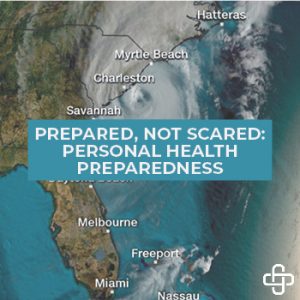 September is National Preparedness Month (NPM) which promotes family and community disaster and emergency planning. While most typically associate disaster preparedness to events such as hurricanes, one critical aspect many times overlooked is our personal health preparedness.
September is National Preparedness Month (NPM) which promotes family and community disaster and emergency planning. While most typically associate disaster preparedness to events such as hurricanes, one critical aspect many times overlooked is our personal health preparedness.
What is Personal Health Preparedness?
The CDC explains personal health preparedness is about having the wherewithal to care for and protect your health and wellness in the immediate aftermath of an emergency or disaster. This means having the supplies, skill, and self-confidence to bounce back from a difficult or life-changing event like a natural disaster.
Large-scale events, like hurricanes, can cause widespread destruction and long-lasting power outages, disrupt supply chains, and strain public health and health care systems.
When access to resources and the availability of services is limited, it is important to have an emergency supplies kit that includes items from the following categories:
- Personal needs
- Prescriptions
- Paperwork
- Power sources
- Practical skills
Personal Needs
Personal needs refer to the unique items—supplies, equipment, and tools—you need to protect your physical, mental, and emotional health and safety in an emergency.
Prescriptions
About half of all Americans take prescription medication as part of their daily routine. Yet, according to a survey done by FEMA in 2012, only 8 percent of respondents said they have medications in their emergency supplies kit. Because a disaster could make it difficult to find an open pharmacy and/or get your prescription filled, it is important that you organize and protect your prescriptions, over-the-counter drugs, and vitamins to prepare for an emergency.
Paperwork
Paperwork refers to any important papers that might help you prove medical coverage, ownership, or your identity after an emergency. Collect and protect insurance cards, identification documents, and copies of emergency action plans to prepare for a short-notice evacuation because of a wildfire, earthquake, or other events.
Power Sources
On average, people experience about four hours of power loss each year. Power outages caused by a large-scale disaster can last much longer and—as a result—can become life-threatening for people who rely on electrically powered medical equipment and devices. Be prepared for a prolonged blackout with alternative heating and lighting, and backup power sources for your cellphone, appliances (i.e., refrigerator), and power-dependent medical devices.
Practical Skills
Practical skills are self-health and life-saving skills and lessons that you can learn and practice—some of them every day—to prepare for an emergency. Teach and encourage those around you to learn practical skills. When family, friends, neighbors, and coworkers complete CPR training, for example, it protects your health (you can’t perform chest compressions on yourself) and can help build resilience in your community.

Holly is an ER nurse by trade, but loves content marketing. She was born outside the box and believes everything is better with “sprinkles and sparkles”. She is passionate about impacting lives and uses marketing as her platform for sharing practical solutions to address real life occupational health challenges.
Find out more about our Injury Case Management services or our Occupational Health Programs.










